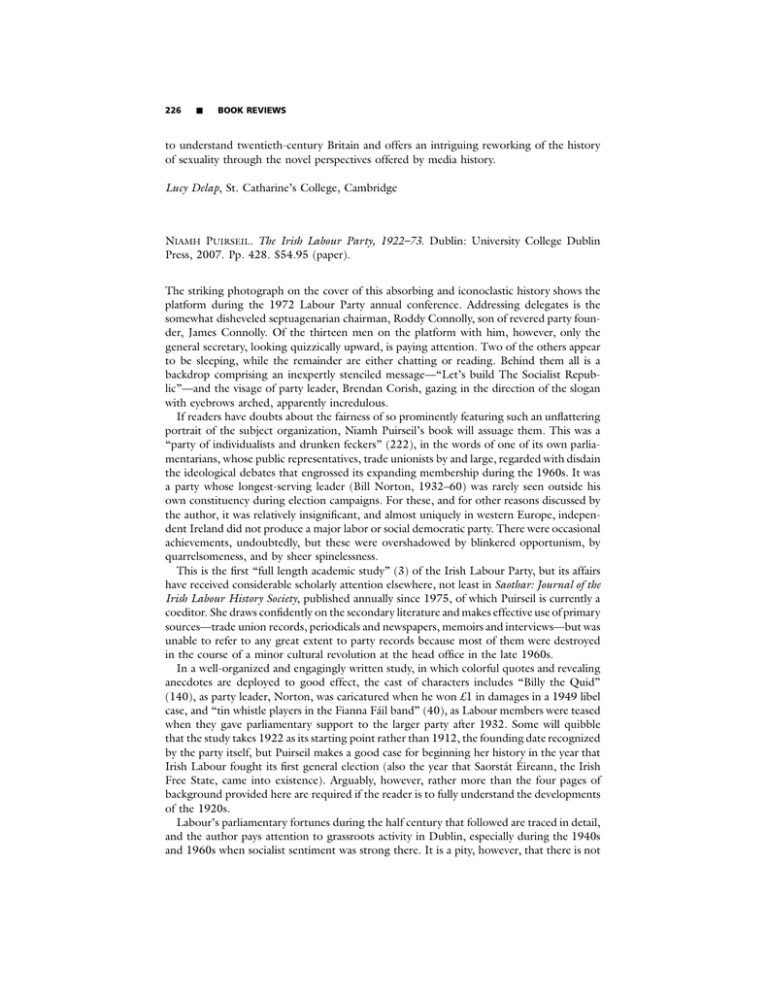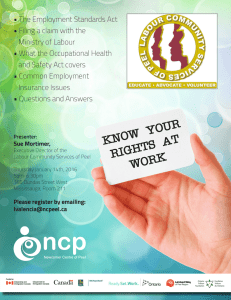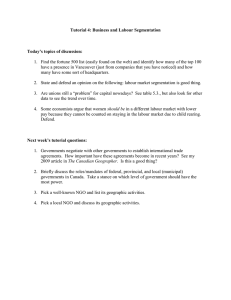to understand twentieth-century Britain and offers an intriguing reworking of... of sexuality through the novel perspectives offered by media history.
advertisement

226 䡵 BOOK REVIEWS to understand twentieth-century Britain and offers an intriguing reworking of the history of sexuality through the novel perspectives offered by media history. Lucy Delap, St. Catharine’s College, Cambridge NIAMH PUIRSEIL. The Irish Labour Party, 1922–73. Dublin: University College Dublin Press, 2007. Pp. 428. $54.95 (paper). The striking photograph on the cover of this absorbing and iconoclastic history shows the platform during the 1972 Labour Party annual conference. Addressing delegates is the somewhat disheveled septuagenarian chairman, Roddy Connolly, son of revered party founder, James Connolly. Of the thirteen men on the platform with him, however, only the general secretary, looking quizzically upward, is paying attention. Two of the others appear to be sleeping, while the remainder are either chatting or reading. Behind them all is a backdrop comprising an inexpertly stenciled message—“Let’s build The Socialist Republic”—and the visage of party leader, Brendan Corish, gazing in the direction of the slogan with eyebrows arched, apparently incredulous. If readers have doubts about the fairness of so prominently featuring such an unflattering portrait of the subject organization, Niamh Puirseil’s book will assuage them. This was a “party of individualists and drunken feckers” (222), in the words of one of its own parliamentarians, whose public representatives, trade unionists by and large, regarded with disdain the ideological debates that engrossed its expanding membership during the 1960s. It was a party whose longest-serving leader (Bill Norton, 1932–60) was rarely seen outside his own constituency during election campaigns. For these, and for other reasons discussed by the author, it was relatively insignificant, and almost uniquely in western Europe, independent Ireland did not produce a major labor or social democratic party. There were occasional achievements, undoubtedly, but these were overshadowed by blinkered opportunism, by quarrelsomeness, and by sheer spinelessness. This is the first “full length academic study” (3) of the Irish Labour Party, but its affairs have received considerable scholarly attention elsewhere, not least in Saothar: Journal of the Irish Labour History Society, published annually since 1975, of which Puirseil is currently a coeditor. She draws confidently on the secondary literature and makes effective use of primary sources—trade union records, periodicals and newspapers, memoirs and interviews—but was unable to refer to any great extent to party records because most of them were destroyed in the course of a minor cultural revolution at the head office in the late 1960s. In a well-organized and engagingly written study, in which colorful quotes and revealing anecdotes are deployed to good effect, the cast of characters includes “Billy the Quid” (140), as party leader, Norton, was caricatured when he won £1 in damages in a 1949 libel case, and “tin whistle players in the Fianna Fáil band” (40), as Labour members were teased when they gave parliamentary support to the larger party after 1932. Some will quibble that the study takes 1922 as its starting point rather than 1912, the founding date recognized by the party itself, but Puirseil makes a good case for beginning her history in the year that Irish Labour fought its first general election (also the year that Saorstát Éireann, the Irish Free State, came into existence). Arguably, however, rather more than the four pages of background provided here are required if the reader is to fully understand the developments of the 1920s. Labour’s parliamentary fortunes during the half century that followed are traced in detail, and the author pays attention to grassroots activity in Dublin, especially during the 1940s and 1960s when socialist sentiment was strong there. It is a pity, however, that there is not BOOK REVIEWS 䡵 227 more on party organization in those constituencies in which Labour performed best electorally, which were outside the capital. Without this, the relationships and structures that produced and sustained the “individualists” who predominated in the parliamentary party remain opaque. Puirseil’s narrative may be summarized as follows. In the critical election of 1922, Labour caused surprise, not least to itself, when it outpolled the antitreaty Sinn Féin faction (but won fewer seats, although unlike the antitreatites, Labour’s representatives took their seats). The 1922 result was to be an electoral high point, however, and during the following decade, the party was overly cautious on policy, inattentive to organizational matters, and more self-important than was justified by its level of support. The populist Fianna Fáil party, established in the antitreaty milieu in 1926, was consequently able to lay claim to a large slice of the working-class constituency. During the 1930s, Labour moved leftward for a period in order to better distinguish itself from Fianna Fáil, but it quickly retreated to the center rather than risk attracting the wrath of the ascendant Catholic Church. During the so-called emergency period of 1939–45, a leftward tendency among the Dublin membership—stoked, to some extent, by “entryists” from Communist and Trotskyist groups—led to a “red scare,” to the secession in 1944 of a right-wing parliamentary faction associated with the important Irish Transport and General Workers’ Union, and to an exemplary purge of some leftists. In 1948, Labour entered government for the first time, as part of a fiveparty coalition (which included the secessionist National Labour). While the 1944 schism was repaired before the government collapsed, the reunited party emerged with little credit— having joined the Catholic bishops and the medical profession in opposing the health minister’s progressive “Mother and Child scheme,” having had one of its ministers implicated in a notorious jobbery scandal, and having been thwarted in its efforts to reform social welfare. After another disastrous experience in government (1954–57), participation in coalition was renounced by Labour, a position that was maintained throughout the 1960s. In a somewhat more tolerant atmosphere, the party was able to tailor its message to the radicalized urban young, to recruit for the first time a considerable number of left-wing intellectuals, and to predict that “the seventies will be socialist.” Despite another red scare, significant electoral progress was made. It was less than was expected, however, and in their disappointment, the skeptical old guard and the upstart intellectuals agreed that the 1970s would not be socialist after all and that coalition with a larger conservative party was preferable to indefinite exclusion from office. This volte-face caused consternation among the more idealistic sections of the membership at a time when there were also profound political differences in relation to the crisis in Northern Ireland. Party conferences of the early 1970s, consequently, were heated, disorderly, and more than a little confused. Some sense of this atmosphere is conveyed in the cover photograph described above. In a work that so forensically and so damningly chronicles a party’s failings, it comes as a surprise when the conclusion largely absolves those responsible. Given the social structure of independent Ireland up until the 1970s and the unavoidably sectional nature of the party’s appeal, Puirseil contends, Labour was fated to be a minority party. For much the same reason, its election campaigns were underresourced by comparison with others. Any effort to broaden the party’s appeal by offering radical or socialist alternatives was doomed to failure, she concludes, both because this would have galvanized powerful religious opposition and because the overwhelmingly conservative electorate was not interested in such alternatives. The prescriptions of internal critics of the leadership, it follows, would have made things worse rather than better. By this very deterministic line of argument, the internal squabbling, the strategic incompetence, the inhospitable attitude toward new members, and the venality were consequences rather than causes of Labour’s marginal status. While I may disagree with a portion of the analysis, the work may be recommended 228 䡵 BOOK REVIEWS without reservation. Puirseil’s is a well-researched and well-written study that adds substantially to an understanding of the Irish Labour Party. John Cunningham, National University of Ireland CHRISTINA JULIOS. Contemporary British Identity: English Language, Migrants and Public Discourse. Studies in Migration and Diaspora. Aldershot: Ashgate, 2008. Pp. 198. $99.95 (cloth). As the global lingua franca, Christina Julios alleges, the English language has been unduly understudied and underrated by historians as a forger of national identity. Its lingual influence is explained as a syndrome of the British Empire and its residues and of U.S. power (today 70 percent of English speakers are living in U.S. territories) since the cold war and through technologies from film to the Internet. By looking at minority experience comparatively— the Puerto Rican community and legal precedents dealing with race, education, and language in the United States, for instance, take up a large part of chapter 3—the context for exploring a multicultural, multifaith, and multiethnic Britain is set up. So apart from dealing with English as a second language and the other languages of English speakers, language operates here as an ideological tool of nation shaping. This linguistic turn was notably apparent when the 2002 Nationality, Immigration, and Asylum Act made language proficiency a test of citizenship. As befits her ambition to bridge academic and policy debates, Julios is most sure-footed when treading in more contemporary debates—from the urban riots of the early 1980s, but also touching on the Stephen Lawrence case and the Sangatte “refugee camp” in France, through to the 2007 Big Brother fracas and Jack Straw’s comments on his unease at Burkaclad Muslim constituents. This is particularly the case with language and education policy, which are the author’s forte and the book’s centerpiece. Julios argues that language teaching is a key site on which the shift from a multicultural approach allowing for diversity (from the 1960s) to one stressing integration and cohesion (through fears of social separatism and fragmentation since the 1980s) took place. The 1966 Local Government Act was the apex of the multicultural approach, funding local authorities with large immigrant populations to maximize equal educational opportunities. By 2004, when foreign modern languages (not English or Welsh and Gaelic, which remained compulsory) became optional for General Certificate of Secondary Education (GCSE) students, the numbers studying languages from GCSE to the degree level fell significantly. Julios describes this as constituting “an ideological shift from a multilingual educational approach to a predominantly Anglocentric model” (126) but also admits that this was a complex process. Uncertainties were rife in government policy, and the longerterm shift was facilitated by the differentiation between “core” and “other foundation” subjects introduced as early as the 1988 Education Reform Act. Or, to take another example, the Runnymede Trust’s The Future of Multi-Ethnic Britain (2000) was less ready to see diversity as at odds with social cohesion and urged consideration of “equality” as a unifying factor. The emergent focus on the English language as a key binding of Britishness sat uneasily with the European Union’s multilingual vision of citizenship, not to mention the New Labour rhetoric of inclusiveness and global competitiveness. But the paradox Julios does effectively convey here was that the globalization of English simultaneously permitted a more insular conception of national identity. As a compendium of a wide range of legislation, government and think-tank reports on education, and race relations (from 1985’s Swann Report through Nuffield Foundation and PEP reports and to the Cantle [2001], Tomlinson [2005], Dearing [2007] reports and






